
“Mi rather dead pon mi foot than live pon mi knee.”
Those words, though unrecorded, echo the heart of a movement that ignited the fires of Black resistance in the Caribbean. In the forests of Saint Mary in 1760, led by a fallen African king named Tacky, enslaved Africans rose—not just to break chains, but to build a free nation of their own. This was Tacky’s War—an uprising so fierce, so widespread, that some say its only rival in shock value was the American Revolution.
Who Was Tacky?
Before he was enslaved, Tacky was a Fante royal and seasoned war general from the Gold Coast (now Ghana). He had sold rival prisoners of war into slavery—only to later suffer the same fate. Betrayed, captured, and sold to the Dutch, he ended up in Jamaica’s plantation system, a king made captive.
But slavery couldn’t strip Tacky of his leadership, military knowledge, or belief in sovereignty. While to the British he was just another field slave, to his people he was still a king. And in the shadows of colonial Jamaica, Tacky began to build a plan—a rebellion that would stretch from Port Maria to Westmoreland. His goal? Total overthrow of the British in Jamaica.
The Spark of Rebellion
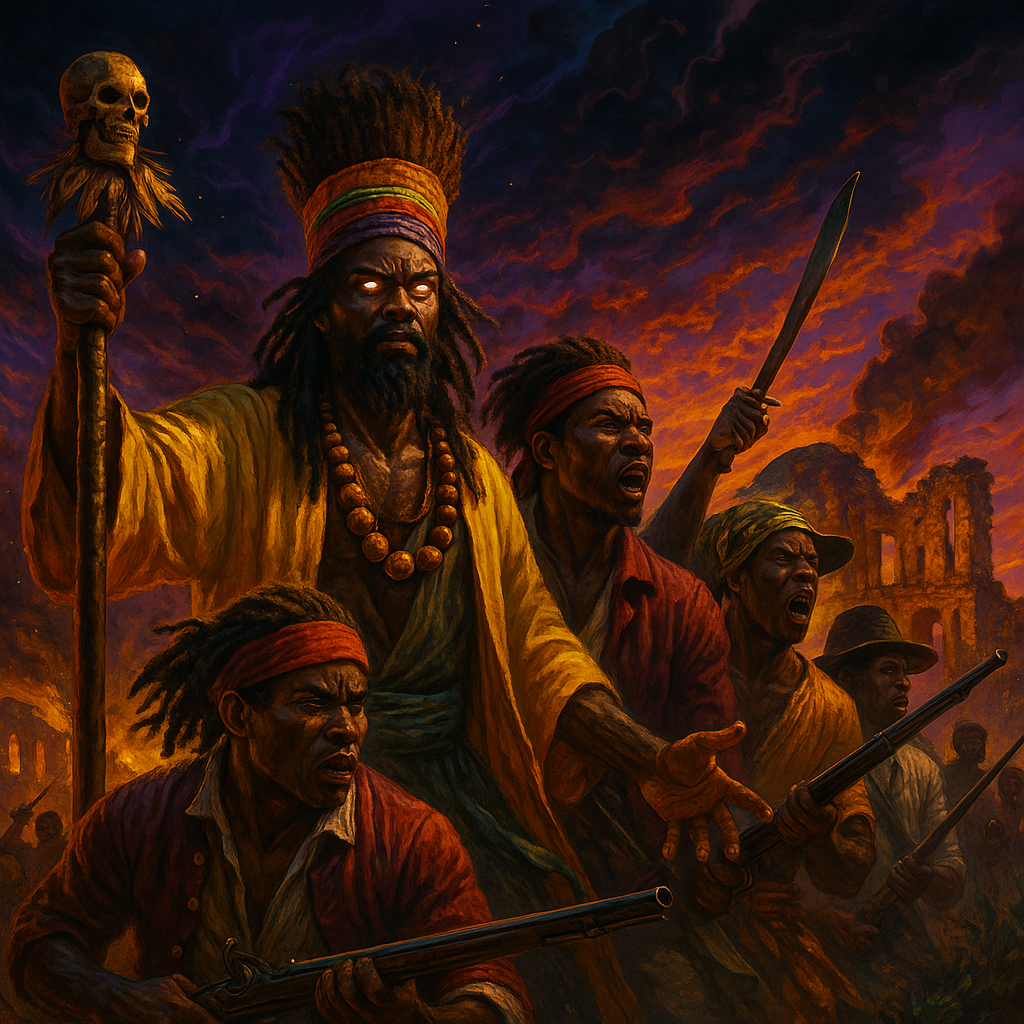
On Easter Monday, April 7, 1760, Tacky and his Coromantee lieutenants—Quaw Badu, Sang, Fula Jati, Sobadou, and Quantee—launched the revolt at dawn.
- Frontier and Trinity Plantations fell first.
- White overseers were killed.
- Enslaved Africans joined in droves.
- At Fort Haldane, they killed the storekeeper and seized gunpowder and 40 firearms.
- The army grew—hundreds strong—bold and organized, rallying under spiritual protection from Obeahmen, who told them they could not die.
Tacky wasn’t just staging a riot—he was building a nation.
A Rebellion Like No Other
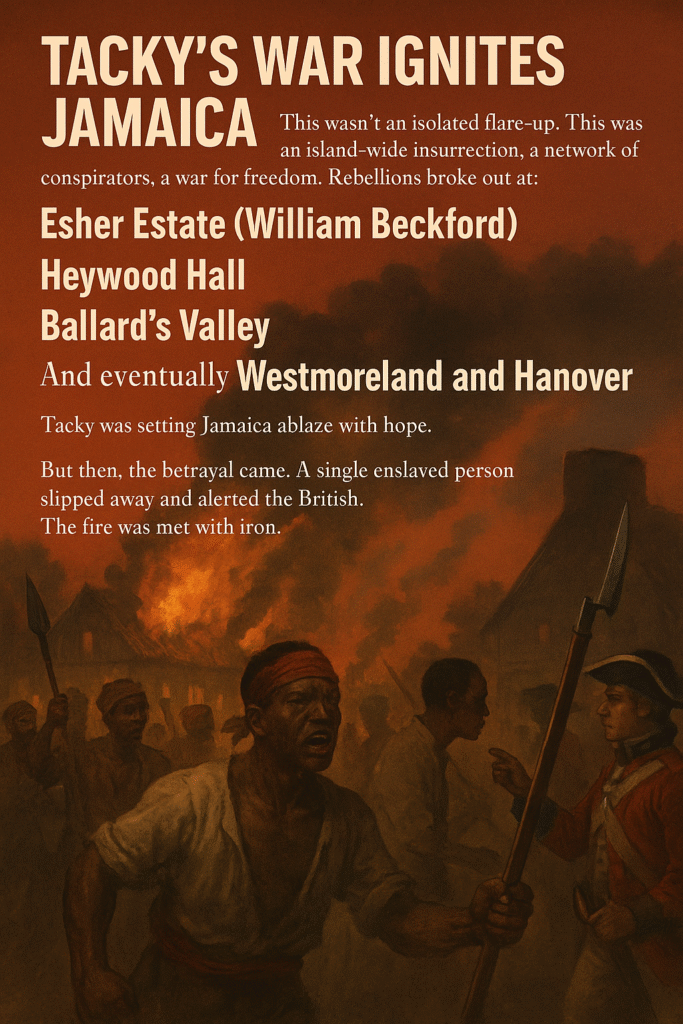
This wasn’t an isolated flare-up. This was an island-wide insurrection, a network of conspirators, a war for freedom. Rebellions broke out at:
- Esher Estate (William Beckford)
- Heywood Hall
- Ballard’s Valley
- And eventually Westmoreland and Hanover
Tacky was setting Jamaica ablaze with hope.
But then, the betrayal came. A single enslaved person slipped away and alerted the British. The fire was met with iron.
The British Counterattack
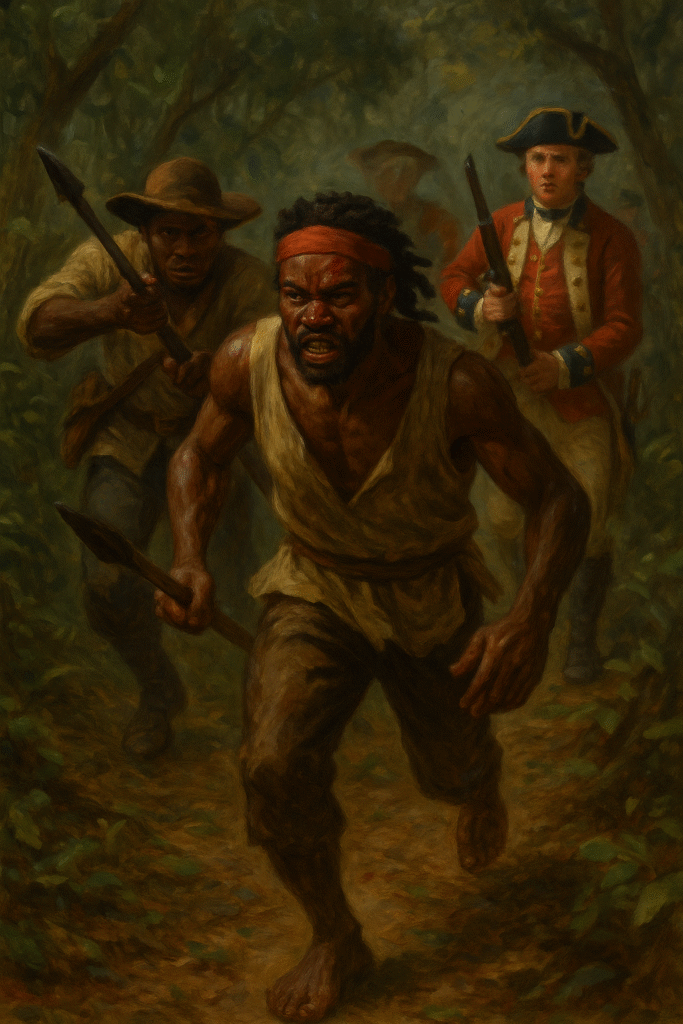
Lieutenant Governor Sir Henry Moore wasted no time. He sent the 74th Regiment—nearly 100 strong—riding from Spanish Town to Saint Mary. With them came Jamaica’s infamous wildcards: the Maroon warriors of Charles Town, Moore Town, and Scott’s Hall.
Bound by treaties to the British, the Maroons—who had once fought for their own freedom under Queen Nanny—were now tasked with hunting down the very people who were following in her footsteps.
What followed was brutal:
- On April 14, at Rocky Valley, Tacky’s forces were ambushed.
- The battle raged, but the rebels were outgunned and outnumbered.
- Tacky and a few men escaped, fleeing into the hills.
But the Maroons, especially the legendary sharpshooter Davy, were relentless. Davy caught Tacky on the run, shot him, beheaded him, and delivered the grisly trophy to Spanish Town, where it was displayed on a spike for all to see.
The message was clear: defy the Crown, and perish.
Mass Suicide at Tacky Falls
With their leader gone, many of Tacky’s men chose death over re-enslavement. In a cave near Tacky Falls, dozens took their own lives—leaving behind a legacy of courage that would echo through the mountains and rivers of Jamaica for centuries.
The Western Front: Apongo’s Rebellion

While Tacky’s death stunned the island, another king was just getting started.
His name was Apongo—a Dahomey war general renamed “Wager” by his enslaver, naval officer Arthur Forrest. On May 25, Apongo launched a new rebellion at Masemure Estate, Westmoreland.
This time:
- Rebels were armed, organized, and wore stolen European finery: laced hats, ruffled shirts, cravats.
- They held off the British at the Barricade near Bluefields Bay.
- They repelled militia attacks, executed plantation overseers, and even forced the colonial government to declare martial law.
Apongo’s army waged guerrilla warfare from the forests, supported by over 1,200 rebels. They fought for more than a year.
Apongo was eventually captured, caged, and left to die of starvation in iron. But his rebellion lived on.
Queen Cubah: The Forgotten Monarch
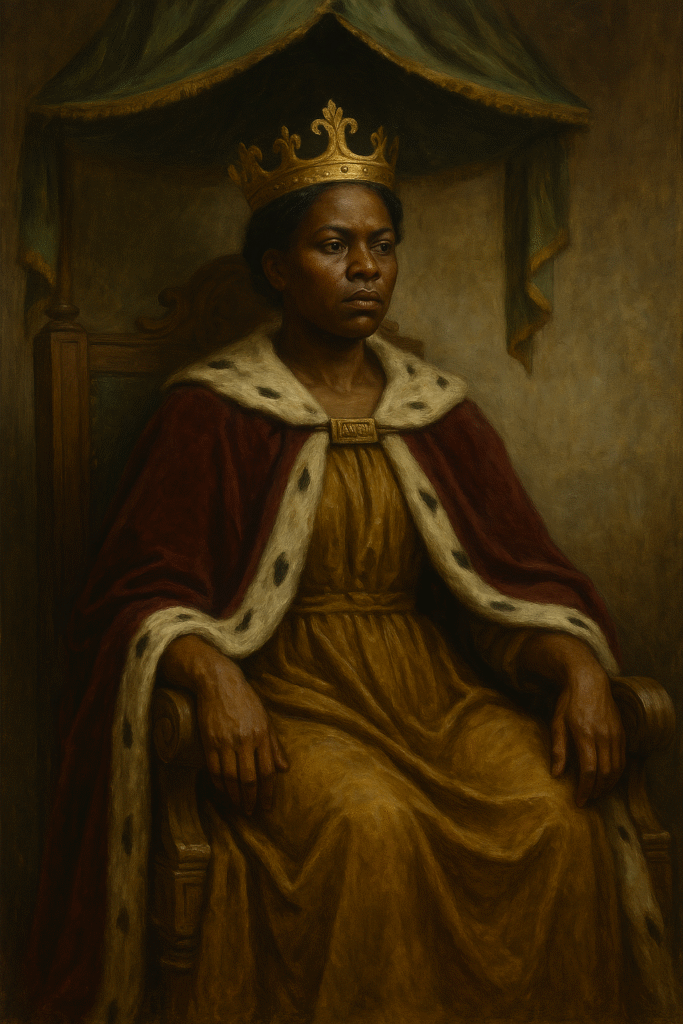
As the island burned, whispers spread of a woman named Cubah, enthroned in Kingston. The Cromanty people had crowned her “Queen of Kingston.” She held court in royal robes, under a canopy, and dreamt of Black sovereignty.
When colonial authorities found out, she was exiled, escaped custody, reunited with rebels, and was eventually executed—another martyr of the movement.
Retribution and Resistance
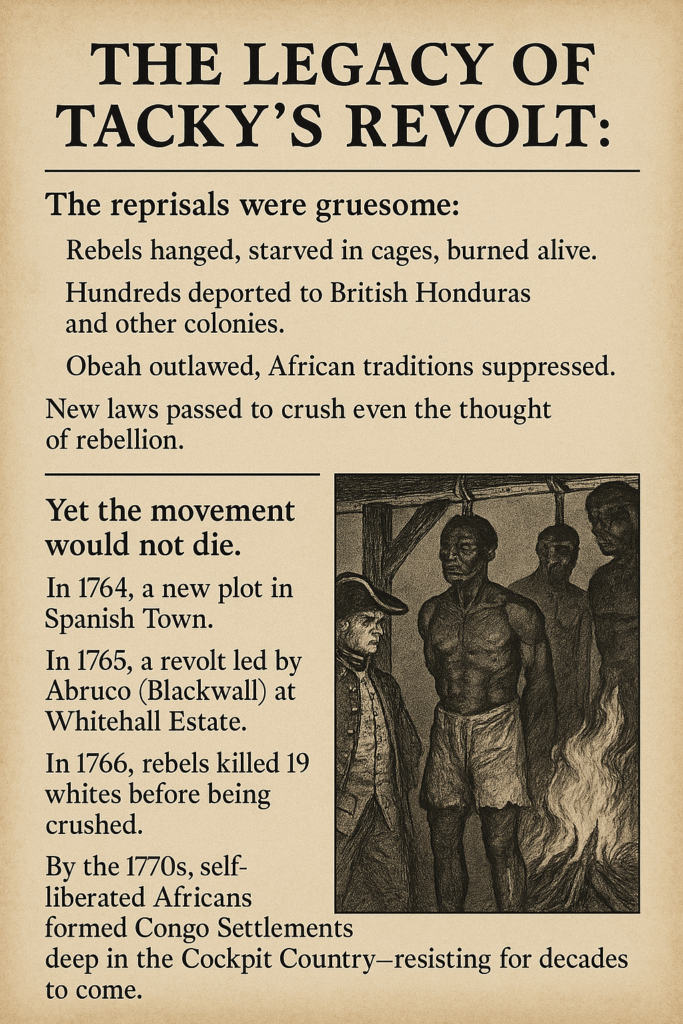
The reprisals were gruesome:
- Rebels hanged, starved in cages, burned alive.
- Hundreds deported to British Honduras and other colonies.
- Obeah outlawed, African traditions suppressed.
- New laws passed to crush even the thought of rebellion.
Yet the movement would not die.
In 1764, a new plot in Spanish Town.
In 1765, a revolt led by Abruco (Blackwall) at Whitehall Estate.
In 1766, rebels killed 19 whites before being crushed.
By the 1770s, self-liberated Africans formed Congo Settlements deep in the Cockpit Country—resisting for decades to come.
Legacy: More Than Chains Could Break
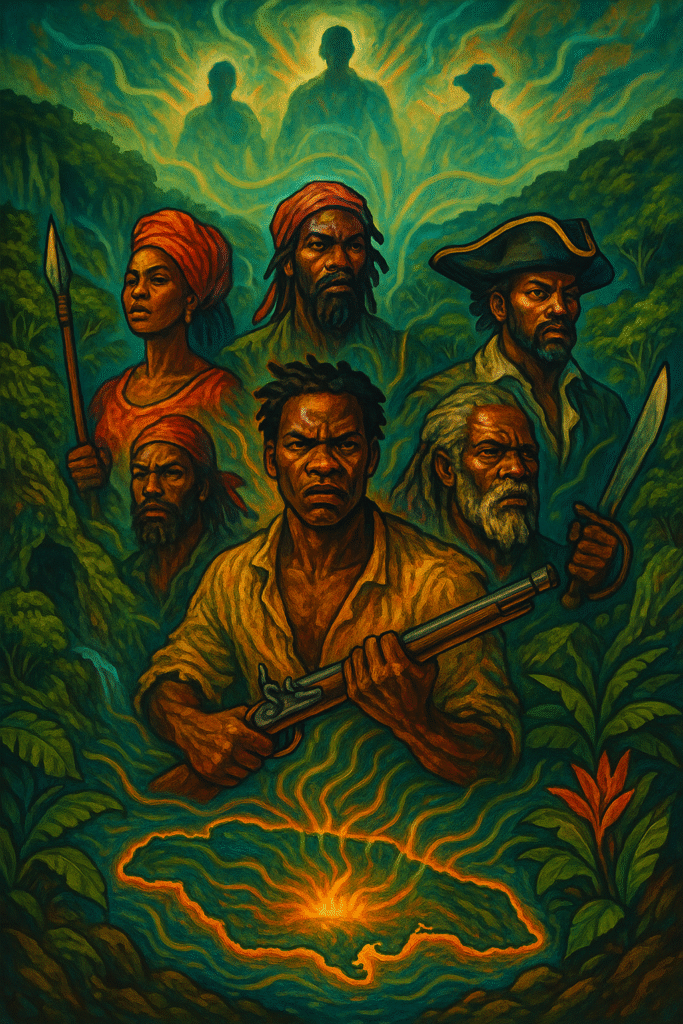
Tacky’s Rebellion failed militarily, but it succeeded in spirit.
It exposed the fragility of British control.
It inspired generations of resistance.
It helped lay the groundwork for the Baptist War of 1831, led by Sam Sharpe.
It played a part in pushing the British Empire toward Emancipation in 1834.
Jamaica’s fight for freedom didn’t start with Bogle or Garvey.
It started with Tacky. With Apongo. With Cubah. With Simon. With nameless rebels who died in caves and forests—never to be remembered by statues, but always by the land.
Visit Their Memory
- Tacky Monument in Claude Stuart Park, Port Maria
- Tacky Falls, near the coast of Saint Mary
- Cave of Martyrs – its location lost, but its legend lives on
Final Word
Tacky’s Rebellion was more than an uprising. It was Jamaica’s first true war of liberation—a battle not just for freedom, but for a vision of Black independence, power, and pride.
In the words of historian Vincent Brown:
“Apongo’s rebellion may have been militarily stronger, but Tacky’s Revolt shook the foundations of the colonial world.”
We stand today on land once soaked in blood—of warriors, of mothers, of freedom fighters. Let us honor them not just with memory—but with movement.
Written by Destination Jamaica™
Rooted in truth. Walked in pride.
This is Jamaica—not as they tell it, but as we lived it.
#KnowYuhRoots #TackysRevolt #JamaicanHistory #BlackLiberation #FromChainsToChampions #BarefootJamaica
